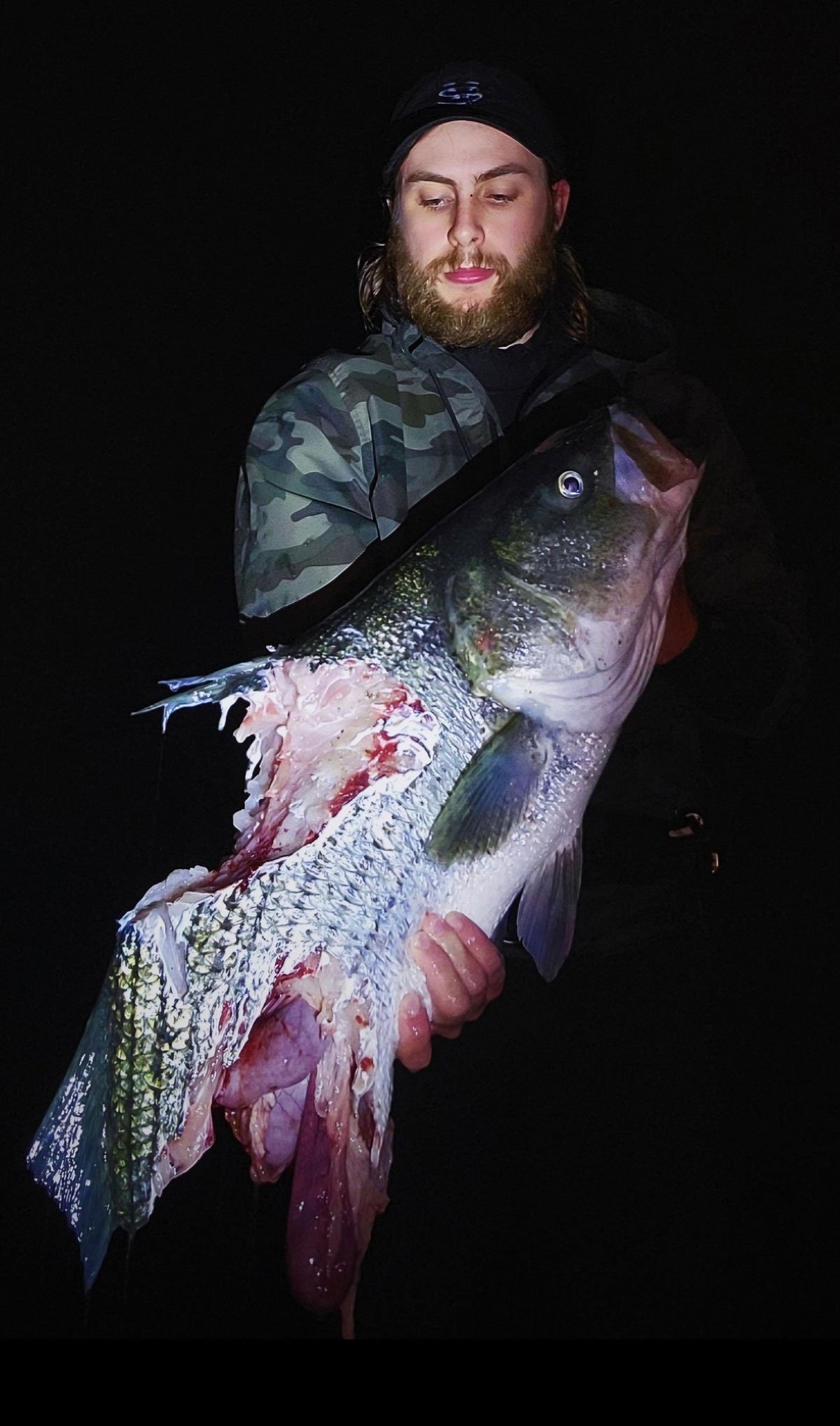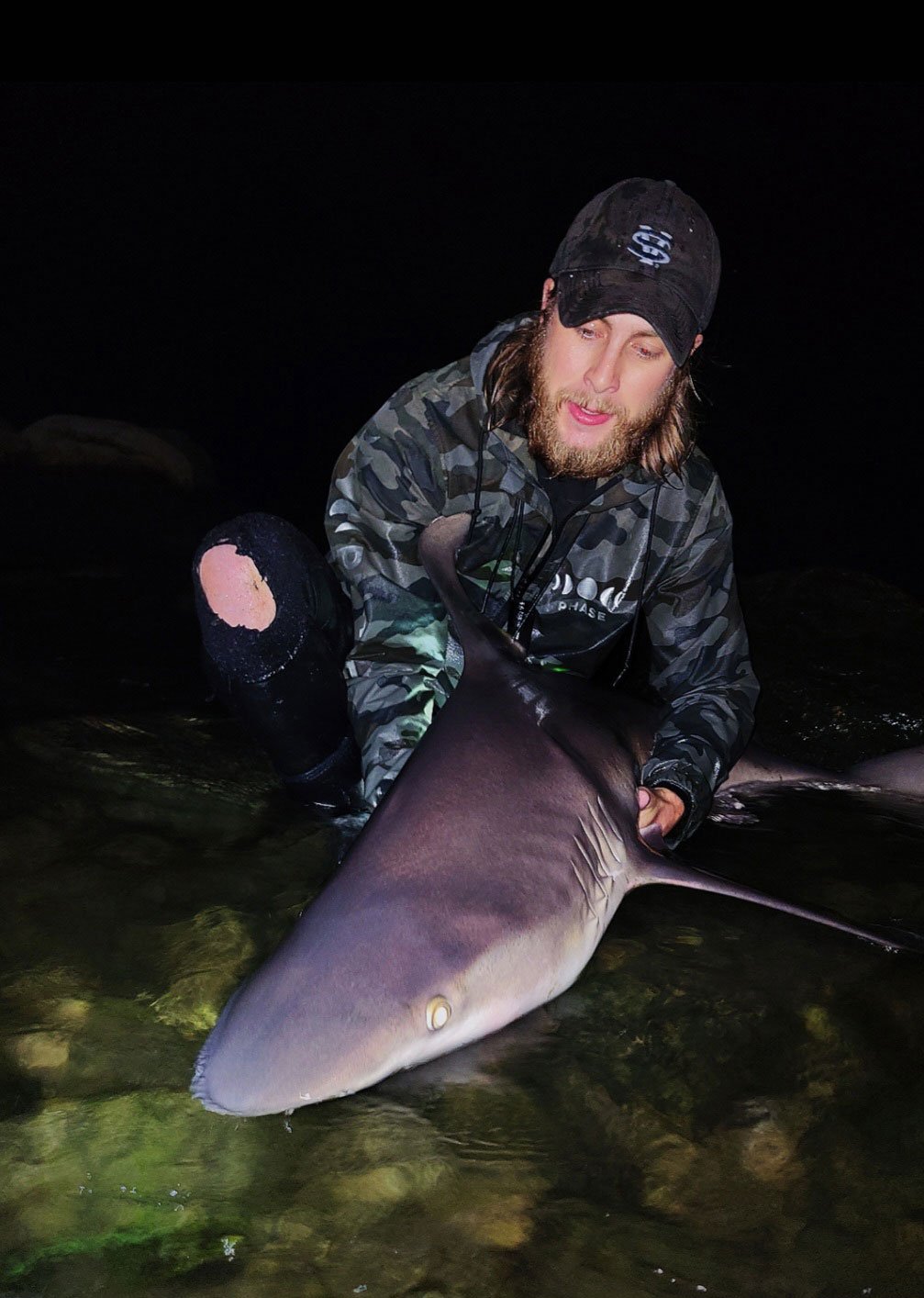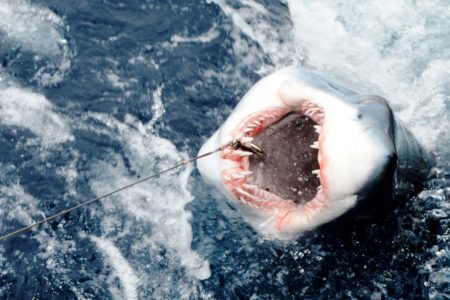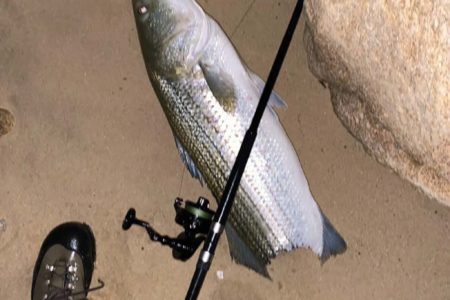
Shark encounters have become increasingly common in the surf!
The linesider turned broadside, exhausted in the warm waters of the summer night. Bioluminescence roiled around her form, a ghostly visage through the salted window of a glassy black surface. For a moment’s breath I paused, faint ripples washing against my waterline perch. Her broom tail stirring, barely breaking the steamy tension of the surface. Without warning, the tranquility was shattered in a spray of tossed foam, tinged crimson under the lights of pinprick stars. My rod bucked violently, loading into a dogged thrashing headshake. Bending double in an improbable curvature before snapping back.
The shark spun, circling. A brown mottled dorsal cutting a wake through the disturbed waters, keyed on its crippled prey. Black eyes reflecting the phosphorescent glow of the tide before rolling back into milky orbs, poised for the second strike.
Accepting Reality
Late into one choppy night tide and neck deep in a rolling surfline a wetsuiting buddy of mine turned to voice the often unspoken question. “Do you ever think about the sharks”? With the discussion bouncing between bounding sets of the surf we had to agree. These predators are most likely to leave you entirely alone, or they won’t. In any case there just isn’t much use in worrying about the matter.
There’s a certain blunt humor shared among many dedicated surfcasters and wetsuiters. The same I’m sure can be said of free solo rock climbers, base jumpers and other adrenaline fueled hobbyists playing on the riskier edge of their pursuits. For their part the surfcasters experience is an at times dubious, nightly balancing act. Embracing the powerful and largely unpredictable forces that the ocean has to offer, often in the most immersive and vulnerable of positions.
Realistically the greatest threats surfcasters face are the unseen contours and drop offs of the bottom structure, silent and powerful riplines and rogue waves that may appear to swell seemingly out of nowhere, breaking the horizon’s distinction between sea and sky. And yet sharks – the apex predators of our coastal waters – have an inexplicable, almost primal way of jumping to the forefront of our minds when looking out on a dark ocean and considering the hazards the surf has to offer.
Statistically Speaking
At least statistically speaking, fatal shark attacks feature incredibly low on the list of risks in our everyday lives. Historically, bike accidents, aircraft mishaps and lightning strikes all account for more yearly global fatalities than shark encounters.
Of course the surfcaster entering the water night after night to handle thrashing and sometimes bloody fish may skew these odds in the wrong direction. At any rate the presence of these predators is something for the serious surfcaster to be extremely cognizant of. Thankfully, certain precautions can be taken to mitigate the possibility of an encounter while still successfully targeting striped bass.
Apex Predators
Anglers plying the inshore waters of the striper coastline are most likely to encounter brown sharks (carcharhinus plumbeus) commonly referred to as “sandbars”. These sharks range along the Atlantic coast and are frequent visitors to the warm summer waters of Cape Cod. They are typically 4 to 5 feet in length with larger females attaining sizes eclipsing 6 feet. They are opportunistic predators, preying primarily on fish, squid and crustaceans. While browns are generally not considered to be a dangerous species to humans they can pose a consistent and disconcerting presence to the surfcaster during certain periods of the season.
More concerning than the prevalent brown sharks is the thought of the larger apex predators that have become seasonal visitors to our inshore waters. Reports of dusky and bull sharks venturing down along the islands and frequenting the waters of Long Island and New Jersey are becoming more commonplace. Closer to home, the waters of Cape Cod have seen a huge increase in great white sharks, as these fish feed on the Cape’s booming overabundance of seals. Many Cape beaches are now picketed with signs warning of these predators and many surfcasters have stories of encounters with them along both sides of the Cape.
One spot in particular seems to elicit a shark story from almost every surfcaster I’ve quietly discussed it with. Just such a dramatic fishtail involved a juvenile white shark, which venturing too close to shore, had come close to beaching itself on a partially submerged bar. Sending the pair of startled casters scrambling back for higher and safer ground.
Increased Presence
It’s certainly true that shark activity has become seemingly more commonplace in our inshore waters. A quick scroll through the social media accounts and posts of the surfcasting community during the summer months often feature pictures of “sharked bass” usually accompanied by a descriptive and often dramatic narration of the encounter.
Browns in particular are notable for their fearless and often dogged behavior when faced with the presence of a surfcaster. More than once I’ve found myself swimming out to deep structure or scrambling up the face of a submerged boulder just to feel a subtle, grazing bump behind me. Turning in time to see one of these fish cruising away into the night. On many such tides this activity is near constant as they cut through the ripline’s or circle in the quiet pockets, exhibiting a calculated, almost curious understanding of the surfcaster.
The bass themselves do not seem particularly bothered by this predatory presence. Based on my own, admittedly unscientific, observations I’ve come to notice that some of my most consistent big fish bites have occurred in relation to an increase in shark activity. A fact I associate at least in part with the related predatory behavior and biology of both species as they compete for the same sources of local forage.

Gear Considerations
I take a certain level of pride, not only in landing a quality fish but in the experience of handling and safely returning that bass. In the summer months, warm, turbid and poorly oxygenated waters contribute to a greater mortality rate among released bass. A certain level of care has to be taken with these fish to ensure a successful release. Unfortunately these summer waters coincide with the presence of sharks. With their finely-adapted sensory systems the resulting commotion of landing and reviving a bass is a sure way to attract the attention of these opportunistic predators.
I’ve never been one for a sporty fight on light tackle, at least not as far as targeting cow bass in the surf is concerned. When sharks are a factor, heavy tackle capable of quickly turning the fight in your favor becomes a critical component to success.
I fish a stout rod with the backbone to quickly turn and land a bass of some size. Typically a Lamiglas 120-1M, paired with a Van Staal 250 loaded with 50- or 65-pound braid and matched with a heavy leader. This setup typically has the power to quickly end a fight before I draw any unwanted predatory attention.
Fish Handling
Whenever possible I try to land a fish from a firm and dry footing. Either from a rocky perch or by walking the fish back to shore before I attempt to handle and revive. However as a surfcaster who spends much of their time in the water, it’s sometimes unavoidable that I’ll be forced to land a fish from a semi submerged position.
On another memorable night, waist deep in the surf I was just reaching to leader a healthy slot bass when a large brown passed behind me, almost grazing my wetsuit as it swung to take a pass at my fish! In these instances a fish-gripper becomes more than just a matter of convenience. I’ve made a habit of landing each bass on my Boga Grip 60. This sizable grip with an extended handle provides me a respectable standoff distance between my hands and any unseen predators. Regardless of how I may set up my surf belt for a night of surfcasting my grip remains in the same orientation, sitting just behind my left hip. This builds up muscle memory acquisition, allowing me to quickly access the tool and land a fish without fumbling around in the dark.
Reviving a fish to ensure a best chance of survival is a process that demands a certain level of attention. Of course being snatched by an opportunistic shark certainly won’t help the survival prospects of the bass. Whenever possible I try to re-acclimate my bass in a sheltered pocket of water, preferably an encircled tidal pool or shallow isolated trough. When this is not possible the grip once again plays a key role, allowing me to work my catch, passing freshly oxygenated water over its gills while offering me a comfortable and hopefully safe working distance.
Strategies For Success
Of all the techniques at the surfcasters’ disposal very few produce large bass more consistently during the summer months than a live eel. However bass are not the only predators that will readily take an eel. Brown sharks in particular, seem to have a certain affinity for these baits, drawn in by the subtle, pulsing vibrations of a lively snake. Sharks can quickly become a troublesome nuisance to an eel-slinger.
On one such tide I found myself stubbornly depleting my supply of live eels and tied rigs as shark after shark would take my eel, either immediately biting through, or tearing off on a blistering run, chafing through my line on the ragged structure. Occasionally these fish would strike, quickly dropping my bait and giving me the opportunity to appreciate the formidable teeth of these predators as I replaced the mangled stub of an eel.
On that occasion I walked out from my spot in the false light of an early morning. After the frustrations of the night my spool was badly in need of fresh line and my supply of hooks and leaders were decidedly sparse.
On other trips I’ve found myself locked into a protracted and grueling fight as I’m forced to attempt to land and then safely release a wayward shark in the rocky, obstacle laden waters. This hazardous and often solo affair is best approached with extreme caution. Anglers handling one of these fish need to be aware of not only the head and teeth but also the powerful body and abrasive sandpaper skin.
Thankfully surfcasters unwilling to tangle with these formidable fish have at their disposal an arsenal of likely alternatives to the live eel. While sharks can and occasionally will strike artificials, I’ve found working plugs, jigs or plastics to be a reliable alternative when the sharks move in.
Introducing eelskin plugs to the rotation should also be a consideration when the goal is to sneak by the sharks. Throughout the summer months I’ll carry an assortment of dressed metal lips, needles and swimmers to suit the conditions. While still presenting that tantalizing snake-like presentation to a bass, a skin plug does not produce the vibration trace or the fresh smell of a live eel that sharks seem to hone in on.
Embracing The Experience
Surfcasting is a primal test, a human choice to step outside of our comfort zone and into an experience that demands a level of respect for forces often outside of our control. Sharks exist as just another natural element within this system. Far removed from the Hollywood stereotypes and headline articles, these elegant and formidable fish are a unique and at times challenging element within this experience.
The mystique of the shark has become firmly ingrained within the collective conscience of the striper coast. Having experienced more than a couple of close encounters with these creatures I’ve found it hard not to admire them, perfectly tuned as they are for their environment. Sharks are a constant and persistent reminder that, as surfcasters, we step out over the edge…where we must embrace the law of the sea.



